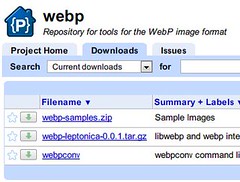Google is developing a new Graphics format called WebP (pronounciated “weppy”). In Google’s efforts to make the Web faster, they already worked out the browser Chrome, a new video format, as well as a possible replacement for HTTP.
Obviously, images consume the largest amount of data needed to transmit when browsing websites. Nowadays, images on the Web are using technologies developed a decade ago, like JPEG or the ancient GIF format.
A first developer preview for WebP proves that image file sizes can be reduced markably, while retaining the image quality. Like JPEG, WebP is a lossy format — while PNG and GIF are lossless. According to Google, images make up to 65% of the received data when browsing a website.
For WebP (Web Picture), Google is working with the VP8 codec already being used in the free video format WebM (Web Movie). The data overhead (header information etc) in WebP images is just 20 bytes per file and can be extended for storing Meta data.
To test the advantages of WebP in the wild, Google has selected one million images by random and converted them to WebP. Most of the files were JPEG files, but also some GIFs and PNGs. The result: In average, the file size could be reduced by 39% while retaining the image quality. Google assumes that the compression can be stronger when starting with uncompressed source images.
On a special website, Google compares WebP images with the same images in other graphics formats. Besides the optical differences, you can view the corresponding file sizes. You want to test WebP yourself? Use the provided conversion tool. For the future, the developers plan to add an alpha channel so WebP can support transparency.
For now, you cannot use WebP on websites, as there is no browser supporting the format. Currently Google is working on Webkit support, so Chrome and Safari will soon be the first browsers being able to display WebP images. Google hopes for other browser manufacturers as well to realize the advantages of WebP and add support, like they did with WebM.

